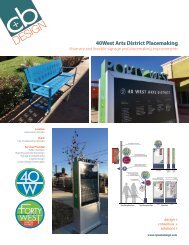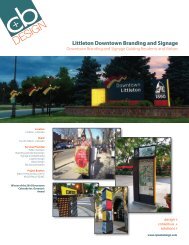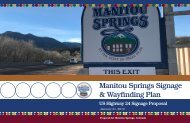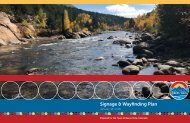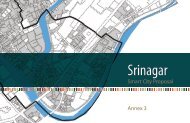Derby Downtown Lighting & Signage Plan
Create successful ePaper yourself
Turn your PDF publications into a flip-book with our unique Google optimized e-Paper software.
ÎÎ<br />
Identify any dimensional or other changes in the overall sign<br />
required by virtue of the fabrication materials, techniques and/or<br />
engineering.<br />
2. ADA recommendations suggest that signs faces be uniformly<br />
illuminated with between 100 to 300 lux (10 to 30 foot candles) of<br />
light and that the illumination level on the sign face is “not significantly<br />
exceeded by the ambient light or visible bright lighting source behind or in<br />
front of the sign.” This is useful in that it provides a range of footcandles<br />
required to be visible by folks with visual limitations, however it is a TOTAL<br />
value, taking into consideration both the ambient lighting (streetlights,<br />
nearby bright signs, etc) and any light produced by the sign itself.<br />
3. Ultimately, the amount of light emitted by the sign must overcome<br />
the ambient light in the surrounding without appearing overly bright or<br />
becoming a distraction/hazard to pedestrians or motorists and (based on<br />
location). Signs should have the ability to be adjusted by the fabricator to<br />
compensate for ambient conditions.<br />
4. Three (3) samples of each material (paint, vinyl, river rock, glass,<br />
etc.) to be used on the sign using actual substrate materials should be<br />
supplied. One sample will be returned, one sent to the Owner and one<br />
kept in the Designer’s records.<br />
5. A proofing document of final production keystroking for all sign<br />
messages to verify line breaks, character and word spacing, and interline<br />
spacing should be submitted. The proofs are to be scaled production art<br />
files, not full sized. Each layout is to be identified with the sign number.<br />
6. The fabricator must prepare and submit a full-scale structural<br />
sample of the structure of pedestrian kiosk and auto directional sign<br />
types. Sample must use final materials and include a complete horizontal<br />
cross section of the sign and at least 1’ of height to show how the<br />
internal system works. Applicable material samples (#4 above) may be<br />
included in this structural sample if the fabricator desires, or the sample<br />
may be unfinished. This sample will be retained by the Designer.<br />
7. The fabricator must submit a 12” x 12” to-scale sample segment<br />
of the map insert product to the Designer for approval before producing<br />
the final map inserts.<br />
8. Fabricator must submit a schedule detailing how far in advance<br />
artwork will be required for printed maps and directories.<br />
9. Fabricator must provide weekly status reports to the Owner and<br />
Designer detailing fabrication and installation progress and the expected<br />
completion schedule.<br />
F. Material Handling<br />
The Fabricator is to pack, wrap, crate, bundle, box, bag, or otherwise<br />
package, handle, transport, and store all fabricated work as necessary to<br />
provide protection from damage by every cause. Fabricator shall provide<br />
clear and legible identifying information on all product packaging to<br />
ensure proper on-site identification and installation.<br />
G. Construction Methodology<br />
The drawings call for a variety of fabrication techniques. Fabricators are<br />
given leeway to fabricate the signs to meet the intent of the designs<br />
depicted by the drawings.<br />
1. Because different systems of extrusions may result in slightly different<br />
dimensional requirements, the total height and width dimensions<br />
described in the sign construction on the drawings may be<br />
considered “nominal” for the purposes of cost quote.<br />
2. Sign faces are to be fabricated using steel plate of varying<br />
thicknesses, as specified on design intent drawings, with a minimum<br />
thickness of .125” inches unless otherwise noted.<br />
3. Sign cabinet seams shall be sealed to ensure they are watertight.<br />
4. All finishes are to be satin finish, free from fading, peeling or cracking.<br />
Paint preparation of all exterior metal surfaces of the sign to include<br />
removal of all scratches and imperfections, sanding and chemical<br />
etching. Substrate cleaning, preparation, paint application and<br />
paint thickness to be in strict compliance with Matthews Paint or<br />
AkzoNobel published recommendations. Acceleration of the drying<br />
process is not allowed.<br />
5. Except where approved otherwise by Owner, conceal fasteners.<br />
6. Any sign faces smaller than 8’ by 20’ are to be fabricated from 1<br />
piece of seamless material.<br />
7. On welded joints, dimensional and structural welding defects will<br />
not be accepted, including but not limited to: poor weld contours,<br />
including excessive bead convexity and reinforcement, and<br />
considerable concavity or undersized welds; cracks; undercutting;<br />
porosity; incomplete fusion; inadequate penetration; spatter; and nonmetallic<br />
inclusions. Welding is to be performed by AWS (or similar)<br />
certified personnel, following AWS Standard Welding Procedure<br />
Specifications (SWPSs) for steel, aluminum, and stainless steel as<br />
appropriate.<br />
8. Non-welded joints between various portions of signs must have<br />
a tight, hairline-type appearance, without gaps. Provide sufficient<br />
fastenings to preclude looseness, racking, or similar movement.<br />
9. Provide drain holes as needed to prevent accumulation of water<br />
within signs. Holes must be inconspicuous and be in inconspicuous<br />
locations; holes must be located such that drainage does not occur<br />
onto signs, or other surfaces subject to staining. Provide internal<br />
system of baffles to prevent “light leaks” through drain holes of<br />
illuminated signs. Provide color-coordinated insect screening over<br />
drain holes.<br />
10. Non-illuminated sign faces are to have lettering and graphics created<br />
as surface-applied vinyl typography using Avery or 3M exterior grade,<br />
minimum 5-year warranty, unless otherwise noted in the design intent<br />
drawings (such as dimensional lettering specified for the kiosks and<br />
other sign types).<br />
11. High pressure laminate panels with embedded artwork are to be<br />
printed at a minimum of 1200 DPI using exterior inks. The panel must<br />
be a solid, one-piece panel with all graphic elements inseparable from<br />
the substrate in which they are embedded (izone, 888.464.9663).<br />
12. Digitally printed graphics are to be printed at a minimum of 1200 DPI<br />
using exterior inks and covered with exterior grade, graffiti resistant<br />
clear lamination.<br />
13. Visible metal joints must adhere to a fit tolerance of .01”.<br />
14. Aluminum and steel components are to be isolated to prevent<br />
galvanic corrosion.<br />
15. Steel components are to be powder coated per the coating<br />
manufacturers specifications to prevent corrosion.<br />
H. Fonts/Typefaces<br />
The fonts used for this project were selected specifically for this project<br />
by the Designer and Owner, and include those listed in the graphic<br />
standards.<br />
It is the responsibility of the fabricator to purchase the fonts.<br />
No substitution of any other typefaces may be made. Under no<br />
circumstances are typefaces to be electronically distorted (“squeezed”<br />
or “extended”) for purposes of fitting to the specified sign or general<br />
alteration of the sign face composition unless noted in the drawings. This<br />
includes (but is not limited to) stretching, squeezing, tilting, outlining or<br />
shadowing.<br />
<strong>Derby</strong> <strong>Lighting</strong> & <strong>Signage</strong> <strong>Plan</strong><br />
97





